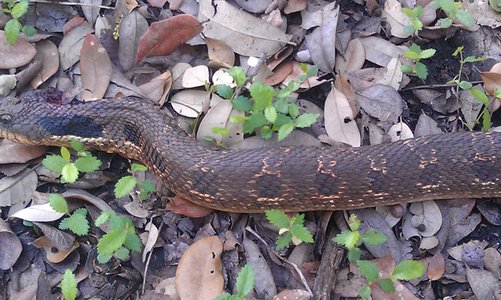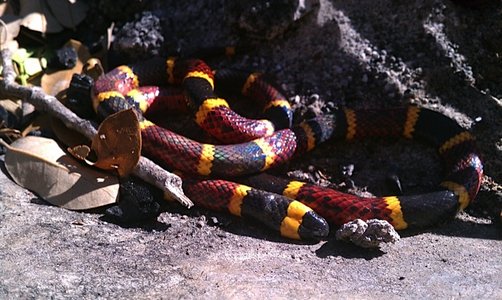Big Country Snake Information
Field Guides
The best handy field guide for our area is a paperback by John Werler and James Dixon called “Texas Snakes” – the photos are spectacular and information is great, and the book is cheap. If you really want detailed information, the same authors have a very comprehensive hard back called “Texas Snakes, Identification, Distribution and Natural History” – a little more expensive, but its the only snake book you’ll ever need, and reads easy.
Andrew Clamann
Luckily, we have a local reptile enthusiast in the neighborhood, Andrew Clamann. He can be reached at 512 576 2285 if you want immediate information with a snake encounter or need him to come wrangle it for you. He’ll happily come by to tell you what it is and even relocate it for you if you really don’t want it around.
Hognose Snakes

Hognose snakes may look intimidating, but they are harmless.
Colors range from black to rusty to light tan. Different regions are different colors – our area is usually either rusty or brown. After hissing, and flattening the neck, its last form of defense is to feign death by rolling over with its mouth open. Its really interesting to watch. They like to eat toads, frogs, mice etc.
Coral Snakes

Coral Snakes show up in Big County here and there, now and then. For those of you unfamiliar with that snake, check out the Houston Herpetological Supply.
From the Texas Parks and Wildlife Website:
The brightly colored Texas coral snake is the state’s only member of the Elapidae family, which includes the cobras of Asia and Africa. The coral snake is slender with a small indistinctive head and round pupils, and is usually is 2-1/2 feet or shorter. Its distinctive pattern is a broad black ring, a narrow yellow ring and a broad red ring, with the red rings always bordered by the yellow rings. Several harmless snakes are similarly marked, but never with the red and yellow touching. ‘Red on yellow, kill a fellow; red on black, venom lack,’ is a handy way to distinguish the highly venomous coral snake from nonvenomous ringed species. Coral snakes are found in the southeastern half of Texas in woodlands, canyons and coastal plains.
Also from the Houston Herpetological Supply:
Generally speaking, the Texas Coral Snake averages 2 to 2 1/2 feet in length as an adult and has a very small head and very small mouth. They also do not have the highly pressurized venom delivery system of the pit vipers, and have fangs that are no more than 1/8 inch long. This means that a coral snake would have to chew on a victim, and I don’t know of too many people that will let ANY kind of snake chew on them for long, let alone a coral snake!!
Neighborhood Snake Sightings
Here are some local neighbor reports on their appearance in June 2008:
Has anyone had recent encounters with coral snakes? This is our third one in three years. It was smallish compared to the other two. The dogs find them then toy with them and kill them. Luckily, I got to this one myself and killed it, before anyone (re: dogs) was hurt.Is this common in our neighborhood?
We’ve lived in Heritage Country for 11 years, and before we built our house, my husband and I did most of the clearing of the building site. We’ve only seen about four snakes total since we’ve moved in–none of them coral or rattlesnakes. I probably shouldn’t even say that since verbalizing it may invite them to come! I’d be interested in what the experience has been for others who live in Big Country or Heritage Country.
I, in the one year I’ve been here (13200 Trail Driver) have never seen a coral snake. Thank goodness. Hopefully you took care of them all and three was the total for the neighborhood!
One coral snake sighting 16 years ago when we first moved on the property. I had young kids, so I got a few chickens and some guinea hens, and nothing since then – including most bugs, especially scorpions.
We are occasionally visited by Carl, a 6 foot chicken snake [aka Texas Rat Snake], who cleans up the eggs that the hens try to hide from us. We give him free reign and he does the same for us. He is actually pretty amusing. If he is spotted he tries to hide and pokes his head around the corner to see if I’m still watching him, and quickly pulls it back. I have mercy on him after a while and let him sneak away. If you see him or others in his family please don’t kill them. He is marked as shown in the attached image, and can appear darker than the one shown here. While the appearance is quite alarming when you aren’t expecting it, he has blotches [not diamonds] and the eye pupils are round and black and fill the entire visible area of the eye [not golden with vertical slits]. Also the tail, if you can see it, comes to a point [not a rattle]. I have found them to be harmless to humans and would likely avoid us except for the snacks that we humans attract and aren’t interested in.
More info on all area snakes
Kevin, you got the snakes who usually visit our porch this time of year. Since they are relatively speaking, not a major threat (coral snakes have to get a hold of their prey and chew to inject venom, hence their prey is usually very very small), we’ve always caught them in a bucket with a tight lid and taken them away.
Snake authorities Werler and Dixon (Snakes of Texas, 2000) were not able to find a single authentic record of a human fatality from coral snakes in Texas since the first known occurance in 1883. Virtually all bites occur because enthusiasts like me pick them up with their hands (the bucket is a much smarter idea). Coral Snakes are inoffensive, reluctant to bite, and essentially unable to effectively defend themselves. If you see one, consider yourself lucky to have seen something of natural and fleeting beauty, and let it be.
Here are some local neighbor reports on their appearance in August 2005:
I have killed 2 coral snakes in my yard in the past two weeks and since I don’t know if this sudden infestation is just my yard or not I thought I’d give a warning. I know that Bobby Porter killed one about 10 years ago in Big Country but we have never seen any until this year and now two in two weeks. It appears that they are most active during the day and the ones we saw were mid-morning and at dusk. Coral snakes are very toxic but are generally not a significant threat to adult humans according to what I have read on the net but could be more of a threat to pets or children.
We had one coral snake about a month ago on our property on Trail Driver. We’ve been here 9 years, and this was the first one. Our dog found it and was just staring at it, which got my attention…
They prefer the bottom lands closer to the drainages, then the upland areas of our neighborhood, but no doubt at one time or another they’ll make to most areas. They are quite reclusive snakes that stay more or less underground most of the time. Coral snake bites are very rare and you’d almost have to stick your finger in it’s mouth to get it to bite you, but needless to say picking one up with a bare hand would not be a good idea. We’ve found three on our property in the 21 years that we’ve been here and I must admit to feeling somewhat guilty about killing two (had one frozen in the freezer for 10 or 12 years until Lynn made me throw it out) of the three we’ve come across, but I guess the reaction falls into the category of “rather safe then sorry”.
For anyone who is interested my Vet recommended someone to “snake train” our dogs. It was $40 per dog and did not take long and by the end of it our dogs wanted nothing to do with the snakes.
We also have had coral snakes on our property right by our house. One large one (2 1/2 feet long) about 6 or 8 months ago and another smaller one (1/1/2ft) about 8 weeks ago. We caught the first one (not an easy task as they move FAST when threatened, though neither tried to strike or bite, they simply wanted to escape) put it in a tightly lidded garbage can and took it to an unpopulated area to be released. This spring we got the second one into a bucket which was too small it escaped, never to be seen again, before we got a lid on to transport it to a safer human free location. Our neighbor had one in his pool about a year ago.
Perhaps this would be a good chance for those of you interested to read up on coral snakes. They are about as deadly to humans (and other vertebrates larger than field mice) as grand-daddy long legged spiders; they simply don’t have the equipment to attack and kill anything of any size with much ease or success.